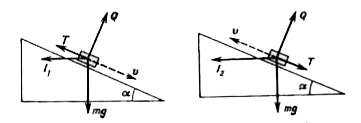In the frame of reference connected with the wedge.
The reference frame fixed to the wedge moves with an acceleration a in the x-direction and therefore is non-inertial. There are four forces acting on the block: the force of gravity mg, the reaction , Q

the friction force T, and the inertial force I = -ma. To solve the problem one should consider the same two cases as in Problem 5.7 (see Fig). The block is not accelerated with respect to the non-inertial frame, and for this reason the sum of the projoctions of forces on both coordinate axes is zero. We have for both cases
y - axis:
Qcosα+Tsinα−mg=0,Qcosα−Tsinα−mg=0
a - axis :
−I1−Tcosα+Qsinα=0,−I2+Tcosα+Qsinα=0
The equations obtained are equivalent to the equations of Problem 5.7, therefore we shall obtain the same answer.
Similar Questions
In the rotating frame of reference connected with the disk.
View SolutionWhat is frame of reference ?
View SolutionFrame OF References
View SolutionAn inertial frame of reference is, by definition,
View SolutionIn a rotating frame of reference.
View SolutionIn a rotating frame of reference.
View SolutionIn a rotating frame of reference.
View SolutionReference Frame
View SolutionThe magnetic force depends on →v which depends on the inertial frame of reference. Does then the magnetic force differ from inertial frame to frame? Is it reasonable that the net acceleration has a different value in different frames of reference?
View SolutionThe magnetic force depends on →v which depends on the inertial frame of reference. Does then the magnetic force differ from inertial frame to frame? Is it reasonable that the net acceleration has a different value in different frames of reference?
View Solution
